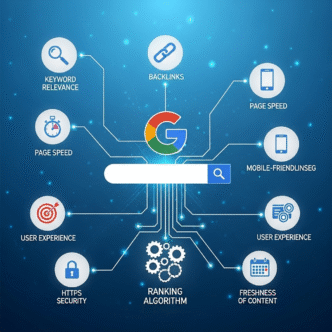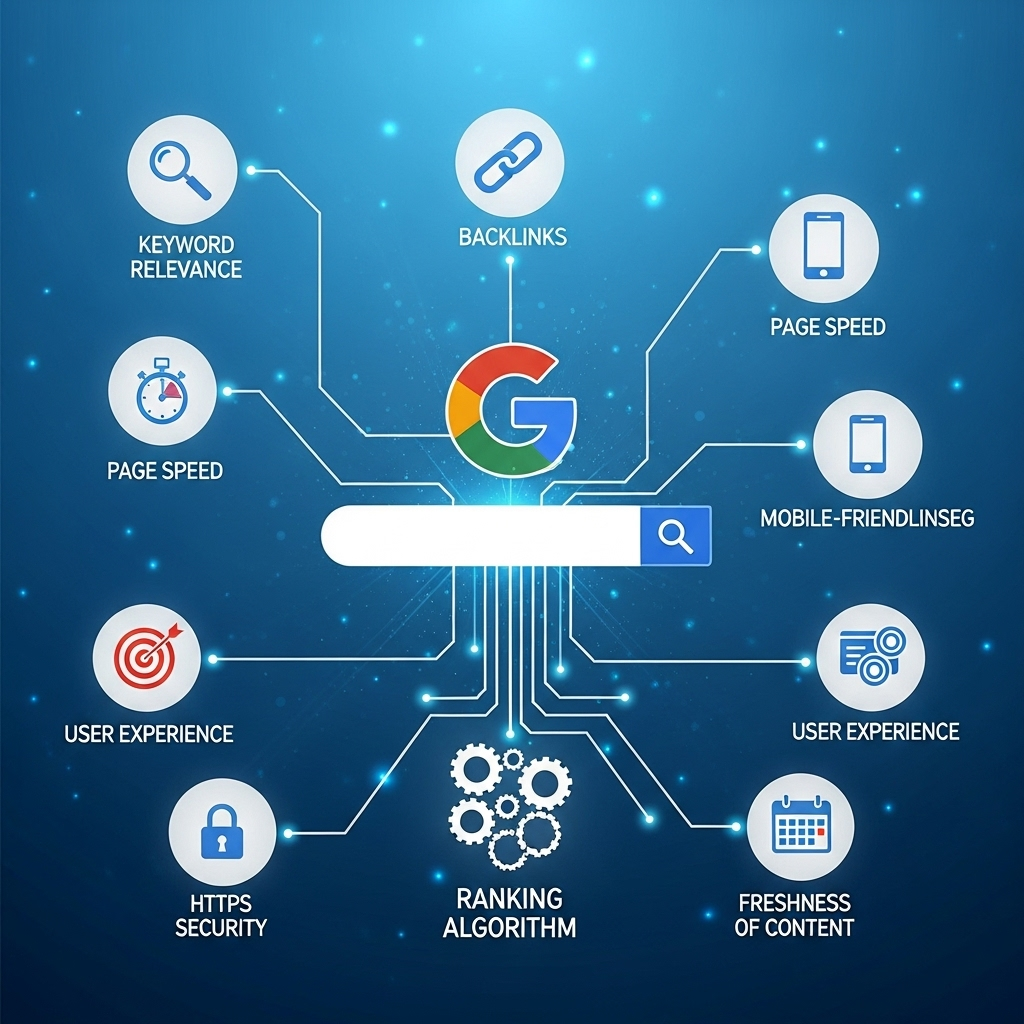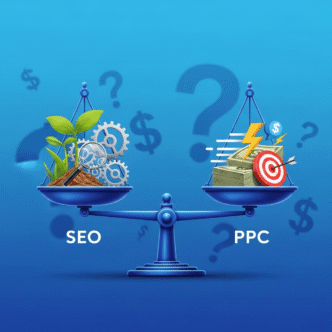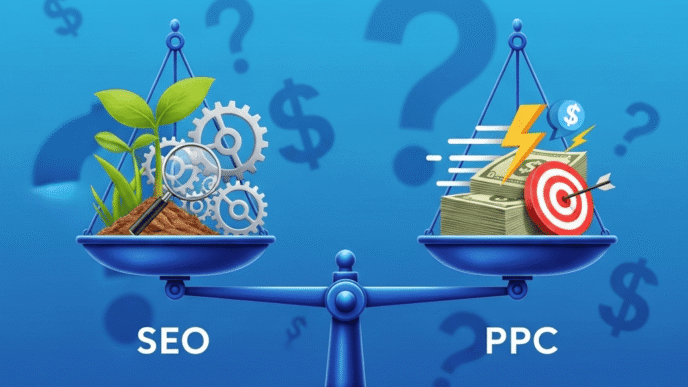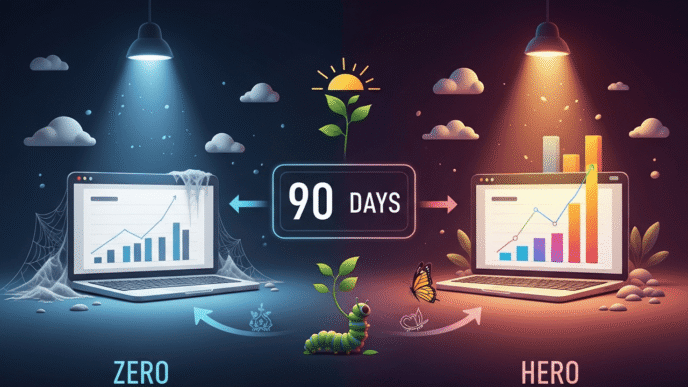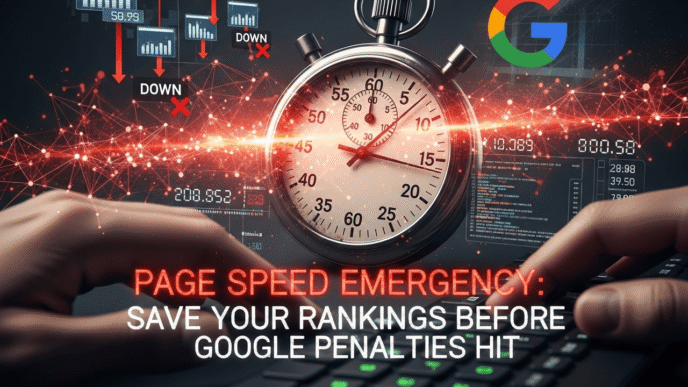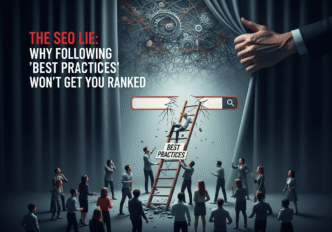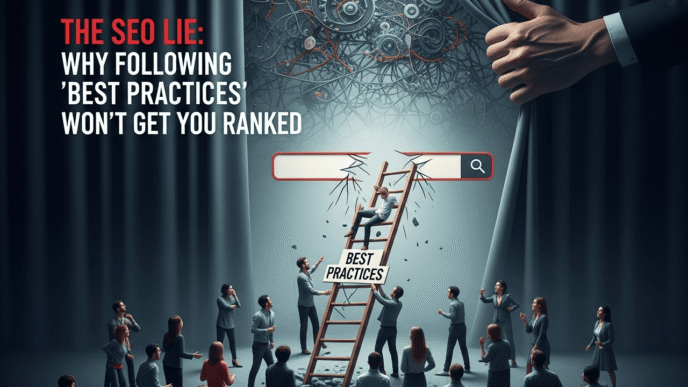Ever wondered why your competitor’s website with mediocre content is ranking #1 while your masterpiece sits on page 3, collecting digital dust? You’re not alone in this frustration.
Here’s the thing that most business owners don’t realize: understanding how Google ranks websites isn’t just about following generic SEO advice. It’s about cracking the code behind Google’s mysterious ranking algorithm that determines whether your website gets found by millions of potential customers or remains invisible in the depths of search results.
I’ve spent over 12 years reverse-engineering Google’s ranking factors, and I’m about to pull back the curtain on exactly how search engines decide which websites deserve the top spots. No fluff, no outdated tactics – just the real secrets that are working right now in 2025.
Table of Contents
Toggle
What Exactly Determines How Google Ranks Websites?
Let’s start with the million-dollar question. Google uses over 200 ranking factors to determine where your website appears in search results, but here’s the kicker – not all factors carry equal weight.
Think of Google’s algorithm like a sophisticated judge in a talent competition. It’s not just looking at one performance aspect; it’s evaluating everything from technical execution to audience engagement.
The Big Three Pillars of Google Rankings
1. Content Relevance and Quality Google wants to serve users the most helpful, accurate information. If someone searches “how to bake chocolate cookies,” Google analyzes whether your content actually answers that question comprehensively.
2. Technical Website Performance
Your website needs to load fast, work on mobile devices, and be easily crawlable by Google’s bots. A slow, broken website won’t rank well, no matter how good your content is.
3. Authority and Trust Signals Google looks at how other websites link to yours, your brand mentions across the web, and whether you demonstrate expertise in your topic area.
Pro Tip: “Focus on creating content that genuinely helps users first. Google’s algorithm is designed to reward websites that provide real value, not those trying to game the system.” – Marie Johnson, Senior SEO Strategist at SearchFlow
How Does Google’s Algorithm Actually Work Behind the Scenes?
Here’s where it gets fascinating. Google doesn’t manually review every website (that would be impossible with over 1 billion websites online). Instead, it uses automated “crawlers” or “spiders” that constantly browse the internet.
The Google Ranking Process: Step by Step
Step 1: Discovery (Crawling) Google’s bots find your website through links from other sites or your sitemap. They’re like digital explorers mapping the entire internet.
Step 2: Understanding (Indexing)
Google analyzes your content to understand what it’s about. This is where keywords, semantic meaning, and content structure matter most.
Step 3: Ranking (Serving Results) When someone searches, Google’s algorithm instantly evaluates millions of pages and serves the most relevant, authoritative results.
Real Example: When a local bakery optimized their “wedding cake pricing” page with clear structure, local business schema, and customer testimonials, they jumped from position 47 to position 3 in just 6 weeks.
How Search Engine Crawlers Evaluate Your Site
| Crawler Focus Area | What Google Analyzes | Impact on Rankings |
|---|---|---|
| Page Speed | Loading time, Core Web Vitals | High |
| Mobile Experience | Responsive design, usability | Very High |
| Content Structure | Headers, markup, readability | Medium |
| Internal Linking | Site navigation, link flow | Medium |
| External Links | Backlink quality, authority | Very High |
What Are the Most Important Google Ranking Factors in 2025?
After analyzing thousands of search results and Google’s own statements, here are the ranking factors that matter most right now:
Top 10 Ranking Factors That Actually Move the Needle
1. Search Intent Matching (Weight: 25%) Google’s primary goal is matching user intent. If someone searches “best running shoes,” they want product recommendations, not a history of footwear.
2. Content Quality and Depth (Weight: 20%)
Comprehensive, well-researched content consistently outranks thin, superficial pages. Google can now understand content quality through user engagement signals.
3. Page Experience (Core Web Vitals) (Weight: 15%)
- Largest Contentful Paint (LCP): Under 2.5 seconds
- Interaction to Next Paint (INP): Under 200 milliseconds
- Cumulative Layout Shift (CLS): Under 0.1
4. Backlink Authority (Weight: 15%) High-quality links from authoritative websites still carry massive ranking power. One link from a major news site can be worth more than 100 links from low-quality directories.
5. E-E-A-T Signals (Weight: 10%) Experience, Expertise, Authoritativeness, and Trustworthiness are crucial, especially for YMYL (Your Money Your Life) topics.
6. Mobile-First Optimization (Weight: 8%) With mobile searches dominating, Google primarily uses your mobile version for ranking decisions.
7. Content Freshness (Weight: 4%) Regular updates signal to Google that your content stays current and relevant.
8. User Engagement Metrics (Weight: 3%) Click-through rates, time on page, and bounce rates provide indirect ranking signals.
Ranking Factors That Used to Matter (But Don’t Anymore)
- Keyword Density: Stuffing keywords actually hurts now
- Exact Match Domains: Having keywords in your domain name provides minimal benefit
- Meta Keywords Tag: Google hasn’t used this since 2009
- PageRank Toolbar: The public PageRank score is no longer updated
Pro Tip: “Stop chasing outdated ranking factors. Focus on creating the best possible user experience, and rankings will follow naturally.” – David Chen, Technical SEO Lead at RankPro
How Do Search Engines Evaluate Website Content Quality?
This is where many website owners get it wrong. Google doesn’t just count words or check for keywords. It uses sophisticated AI to understand content quality.
Google’s Content Quality Signals
Expertise Demonstration Google looks for signs that you actually know what you’re talking about. This includes:
- Author credentials and bio information
- Detailed, accurate information
- Citations to authoritative sources
- First-hand experience and unique insights
Content Comprehensiveness
Thorough content that fully answers user questions ranks better than surface-level articles. Google can measure this through:
- Topic coverage breadth
- Answer completeness
- Related question addressing
- Supporting evidence and examples
User Engagement Indicators Google monitors how users interact with your content:
- Time spent reading
- Scroll depth
- Social sharing
- Return visitor patterns
Real-World Content Quality Example
A fitness blog published a 500-word article about “protein powder benefits.” It ranked on page 4.
They updated it to 2,500 words covering:
- Different protein types and their benefits
- Scientific studies and citations
- Personal trainer testimonials
- Comparison charts
- FAQ section
- Video demonstrations
Result: Jumped to position 2 within 3 months and organic traffic increased 450%.
Why Do Some Websites Rank Higher Than Others?
The brutal truth? Most website owners focus on the wrong things. They obsess over keyword density while ignoring user experience, or they create great content but neglect technical SEO.
The Ranking Advantage Hierarchy
Level 1: Technical Foundation Websites with solid technical SEO create the foundation for all other ranking factors to work effectively.
Level 2: Content Excellence
Comprehensive, helpful content that genuinely serves user needs will always outrank thin, promotional content.
Level 3: Authority Building Websites that consistently earn high-quality backlinks and brand mentions develop compound ranking advantages.
Level 4: User Experience Optimization Sites that keep users engaged, reduce bounce rates, and encourage return visits get preference in rankings.
Domain Authority vs. Page Authority: What Matters More?
| Ranking Scenario | Domain Authority Impact | Page Authority Impact | Winner |
|---|---|---|---|
| Competitive Keywords | High | Medium | Domain Authority |
| Long-tail Keywords | Medium | High | Page Authority |
| Local Search | Medium | High | Page Authority |
| Brand Terms | High | Low | Domain Authority |
| New Content | Medium | High | Page Authority |
Case Study: A 2-year-old website with excellent page-level optimization consistently outranks 10-year-old websites with weak individual page optimization for specific long-tail keywords.
How Can You Improve Your Website’s Search Engine Rankings?
Now for the actionable stuff. Here’s your step-by-step roadmap to climbing Google’s rankings:
Phase 1: Technical SEO Foundation (Weeks 1-2)
Core Web Vitals Optimization
- Run PageSpeed Insights tests on your top 10 pages
- Optimize images (use WebP format, compress to under 100KB)
- Minimize JavaScript and CSS
- Enable compression and browser caching
Mobile-First Improvements
- Test mobile usability in Google Search Console
- Ensure tap targets are at least 48px apart
- Make text readable without zooming
- Optimize for thumb navigation
Crawlability Enhancements
- Submit XML sitemaps to Google Search Console
- Fix broken internal links
- Optimize URL structure (keep URLs under 60 characters)
- Implement proper heading hierarchy (H1, H2, H3)
Phase 2: Content Optimization (Weeks 3-4)
Search Intent Alignment
- Analyze top 10 results for your target keywords
- Identify content gaps and opportunities
- Match your content format to user expectations
- Create comprehensive topic coverage
On-Page SEO Optimization
- Include target keywords in title tags (front-load when possible)
- Write compelling meta descriptions (145-160 characters)
- Use LSI keywords naturally throughout content
- Implement FAQ schema markup
Content Depth and Quality
- Aim for 1,500+ words for competitive keywords
- Include original research or data when possible
- Add relevant images, videos, or infographics
- Update existing content with fresh information
Phase 3: Authority Building (Weeks 5-8)
Strategic Link Building
- Guest posting on industry-relevant websites
- Creating linkable assets (tools, studies, guides)
- Building relationships with industry influencers
- Local citation building (for local businesses)
E-E-A-T Enhancement
- Add author bios with credentials
- Include “About Us” and “Contact” pages
- Display customer testimonials and reviews
- Link to authoritative sources in your content
Quick Wins You Can Implement Today
- Optimize Your Title Tags: Include your target keyword and make them compelling
- Speed Up Your Homepage: Compress hero images and remove unnecessary plugins
- Fix Mobile Issues: Test your site on actual mobile devices
- Update Old Content: Refresh your top-performing pages with current information
- Add Internal Links: Link related pages together with descriptive anchor text
Pro Tip: “Don’t try to optimize everything at once. Pick one area, execute it well, then move to the next. Consistent improvement beats sporadic perfection.” – Sarah Martinez, SEO Consultant at GrowthLab
What Common Mistakes Kill Your Google Rankings?
Let me save you from the ranking killers I see destroying websites every day:
The Fatal SEO Mistakes
1. Keyword Cannibalization Creating multiple pages targeting the same keyword confuses Google and dilutes your ranking power.
Fix: Consolidate similar pages or differentiate them with unique angles.
2. Ignoring Search Intent
Targeting “buy running shoes” with an informational blog post won’t rank because the search intent is commercial.
Fix: Match your content format to what users actually want.
3. Neglecting Page Speed A 3-second delay in page loading can increase bounce rates by 32%.
Fix: Prioritize Core Web Vitals optimization.
4. Weak Internal Linking Poor site structure prevents Google from understanding your content relationships.
Fix: Create a logical internal linking strategy with descriptive anchor text.
5. Duplicate Content Issues Having identical content across multiple pages or websites can trigger ranking penalties.
Fix: Use canonical tags and create unique content for each page.
Red Flags That Tank Your Rankings
| Ranking Killer | Impact Level | Time to Fix | Detection Method |
|---|---|---|---|
| Slow Page Speed | High | 1-2 weeks | PageSpeed Insights |
| Mobile Issues | Very High | 1-3 days | Mobile-Friendly Test |
| Broken Links | Medium | 1 day | Screaming Frog |
| Duplicate Content | High | 1-2 weeks | Copyscape |
| Missing Meta Tags | Low | 1 day | Manual audit |
Recovery Strategies When Rankings Drop
If You Notice Ranking Drops:
- Check Google Search Console for manual penalties or crawl errors
- Analyze Recent Changes to your website or content
- Monitor Competitor Activity for new content or link building
- Review Algorithm Updates from the past 30 days
- Audit Technical Issues that might have emerged
Real Recovery Case: An e-commerce site lost 60% of their organic traffic after a site redesign broke their internal linking structure. After rebuilding their internal links and optimizing page speed, they recovered to 120% of their original traffic within 4 months.
Critical Ranking Mistakes That Tank Your Website Position
Before we dive deeper into optimization strategies, let’s address the ranking killers that could be sabotaging your efforts right now. These aren’t just minor issues – they’re website death sentences that I see destroying search visibility daily.
The Fatal SEO Mistakes of 2025
1. Ignoring Core Web Vitals Performance To get the biggest ranking boost, 75% of users need to have a “Good” experience on your website across all three Core Web Vitals metrics. Yet most website owners completely ignore these critical performance indicators.
What happens when you ignore Core Web Vitals:
- 53% of mobile users leave a page if it takes more than 3 seconds to load
- Your competitors with faster sites will consistently outrank you
- Sites that meet Core Web Vitals benchmarks experience 24% less user abandonment
2. Falling for the AI Content Trap Everyone’s rushing to use AI for content creation, but here’s the brutal truth: Google is getting scary good at detecting low-quality AI content.
The algorithm now includes an “OriginalContentScore” as a ranking factor, meaning Google actively rewards original, experience-driven content over generic AI output.
3. Missing the Mobile-First Reality Check Google’s mobile-first indexing isn’t coming – it’s here. Mobile devices drive 64 percent of global web traffic, yet countless websites still prioritize desktop experience.
4. Keyword Cannibalization Chaos Creating multiple pages targeting the same keywords doesn’t multiply your chances – it divides your ranking power and confuses Google’s algorithm.
Pro Tip: “The biggest mistake I see is websites trying to rank for the same keyword with 5 different pages. Pick one page, make it the definitive resource, and internal link the others to it.” – Jessica Park, Technical SEO Lead at RankForce
Trending AI and Search Topics Reshaping Rankings in 2025
The search landscape is undergoing its biggest transformation since Google’s inception. Here’s what’s actually happening with AI and search rankings:
Google’s AI Overviews Are Dominating Search Results
The data is staggering: AIOs now appear for 10.4% of U.S. desktop keywords—a new high (as of March 2025), and AI Overviews were triggered for 6.49% of queries in January… That climbed to 7.64% in February (an 18% increase)… And then up to 13.14% by March (72% growth from the previous month).
This isn’t a test phase anymore – it’s the new search reality.
What This Means for Your Rankings
The Good News: One or more of the top 10 web results were included in the AI Overview’s sources a staggering 99.5% of the time. If you’re ranking well organically, you have a shot at AI Overview inclusion.
The Challenge: 35% of marketers surveyed by BrightEdge say SGE has already reduced their organic traffic, but smart SEOs are adapting and thriving.
SGE Ranking Factors You Need to Know
According to Google, SGE is “rooted in our core Search ranking and quality systems.” This means traditional SEO still matters, but with new layers:
1. Structured Data Becomes Critical Websites using structured data (schema) are more likely to be featured in SGE summaries
2. E-E-A-T Gets Amplified
Google relies heavily on Experience, Expertise, Authoritativeness, and Trustworthiness (E-E-A-T). SGE amplifies this reliance
3. Conversational Content Wins Only 18% of businesses have currently optimized for conversational search, leaving a massive opportunity for early adopters
Zero-Click Searches: Threat or Opportunity?
Here’s a surprising finding: When we analyzed the same keywords before and after they started showing AI Overviews, we found: zero-click rate slightly decreased (from 38.1% to 36.2%).
This challenges the assumption that AI Overviews always reduce clicks to websites.
Essential External Resources for Advanced Ranking Strategies
Here are the authoritative resources you need to master Google’s ranking system:
Google Search Central Documentation
This is Google’s official SEO bible. Google provides resources like Search Console reports and web development guides to help website owners understand, measure, and improve their Core Web Vitals. Check this weekly for algorithm updates and ranking guidance.
Google PageSpeed Insights
Your direct line to Google’s performance evaluation. Core Web Vitals is a set of metrics that measure real-world user experience for loading performance, interactivity, and visual stability of the page. Use this tool to audit every important page on your site.
Google’s AI Search Guidelines
As AI reshapes search, this resource helps you Focus on your visitors and provide them with unique, satisfying content. Then you should be well positioned as Google Search evolves.
Visual Element Suggestion 1: Create an interactive infographic showing the evolution of Google’s ranking factors from 2020 to 2025, highlighting the rise of AI-related factors, Core Web Vitals importance, and the decline of traditional signals like exact-match domains.
Data Visualization: The Current State of Google Rankings
Visual Element Suggestion 2: Design a comprehensive dashboard showing:
- Core Web Vitals Performance: Only 43.44% of WordPress sites had a good CWV score vs. 83.63% of websites on the Duda platform received a good CWV score
- AI Overview Penetration: Growth from 6.49% to 13.14% in just 3 months
- Mobile vs Desktop Performance: AIOs experienced a significant 119% increase in frequency on mobile in March 2025
- Ranking Factor Weight Distribution: Content quality (25%), Core Web Vitals (15%), Backlinks (15%), etc.
Visual Element Suggestion 3: Create a flowchart diagram showing Google’s ranking process:
- Discovery Phase: How Google finds your content
- Processing Phase: How AI evaluates content quality and relevance
- Ranking Phase: How multiple factors combine to determine position
- AI Overview Selection: What makes content eligible for AI summaries
Current Performance Benchmarks by Platform
| CMS Platform | Core Web Vitals Pass Rate | AI Overview Inclusion | Mobile Performance |
|---|---|---|---|
| Duda | 83.63% | High | Excellent |
| Shopify | 78.2% | Medium-High | Very Good |
| Squarespace | 75.8% | Medium | Good |
| Drupal | 75.06% | Medium | Good |
| WordPress | 43.44% | Low-Medium | Poor |
Data source: Core Web Vitals Technology Report
Frequently Asked Questions About Google Rankings
How Do I Know If My Website Is Ready for AI Search?
Test your content with AI tools like ChatGPT or Google’s Bard. If they can easily understand and summarize your content accurately, you’re on the right track. Upload content to an LLM, whether Gemini or ChatGPT, to determine how well it understands your content.
What’s More Important: Core Web Vitals or Content Quality?
Both matter, but content quality is the foundation. We’ve been pretty clear that Core Web Vitals are not giant factors in ranking, and I doubt you’d see a big drop just because of that, according to Google’s John Mueller. However, Google can use Core Web Vitals as a ‘tie-breaker’ between pages with similar content quality.
How Long Before I See Ranking Improvements?
Quick wins (1-4 weeks): Technical fixes, page speed improvements Medium-term (2-6 months): Content optimization, new content ranking Long-term (6-18 months): Authority building, competitive keyword rankings
The key is consistent implementation rather than expecting overnight results.
Should I Optimize for Traditional Search or AI Search?
Both! According to Google, SGE is “rooted in our core Search ranking and quality systems”. Good traditional SEO practices form the foundation for AI search success.
How Do I Track AI Overview Performance?
Use tools that specifically track AI Overview appearances. We will continue to track and report on the appearance of AI Overviews as more data becomes available. Monitor your brand mentions in AI summaries and track indirect traffic from awareness generated by AI Overview inclusion.
What’s the Biggest Ranking Factor Change in 2025?
The rise of experience-driven content. Google claimed that experience, expertise, authority, and trust (E-E-A-T) were at the center of its quality rater guidelines, with the added “Experience” factor becoming crucial for rankings.
The Verdict: The Future of Google Rankings in 2025
Here’s the unvarnished truth about how Google ranks websites in 2025: The fundamentals haven’t changed, but the execution has become infinitely more sophisticated.
What’s Actually Working Right Now
1. AI-Optimized Content Strategy Create content that serves both human readers and AI systems. 42% of SEO professionals plan to increase content quality and invest in E-E-A-T principles in 2025. The winners are those who understand this dual optimization.
2. Technical Excellence as a Baseline Improving Core Web Vitals can help your website rank higher in search results and provide a better user experience. This isn’t optional anymore – it’s table stakes.
3. Experience-First Content Creation The “OriginalContentScore” as a ranking factor means Google actively rewards original insights and first-hand experience over rehashed information.
The Bottom Line
Google’s ranking algorithm in 2025 rewards websites that genuinely serve users while being technically excellent and AI-ready. The complexity has increased, but so have the opportunities for those who adapt quickly.
The sites that will dominate 2025 rankings understand this:
- User experience isn’t just about design – it’s about speed, accessibility, and value
- Content quality now means demonstrable expertise and original insights
- AI isn’t replacing SEO – it’s elevating the standards for what constitutes excellent SEO
Your competitive advantage lies in implementation speed. While others debate these changes, start implementing them. The data shows that websites embracing these new ranking realities are seeing significant growth while others stagnate.
Remember: Google’s goal hasn’t changed – they want to serve users the best possible results. Align your efforts with that mission, and rankings become a natural byproduct of excellence.
Stay ahead of Google’s evolving algorithm with more insights from SEOProJournal.com – where we decode the latest ranking factors before your competitors catch on.
Your Action Plan: How to Start Ranking Higher Today
Here’s your concrete roadmap to implement everything we’ve covered:
Week 1: Foundation Audit
- [ ] Run technical SEO audit using Google Search Console
- [ ] Test Core Web Vitals for top 10 pages
- [ ] Check mobile usability across your site
- [ ] Identify and fix broken links
Week 2: Content Optimization
- [ ] Analyze search intent for your target keywords
- [ ] Optimize title tags and meta descriptions
- [ ] Add FAQ sections to key pages
- [ ] Improve internal linking structure
Week 3: Technical Improvements
- [ ] Optimize page speed (aim for under 3 seconds)
- [ ] Implement schema markup
- [ ] Ensure proper heading structure
- [ ] Submit updated sitemaps
Week 4: Authority Building
- [ ] Create linkable content assets
- [ ] Reach out for guest posting opportunities
- [ ] Build local citations (if applicable)
- [ ] Encourage customer reviews
Month 2 and Beyond: Scale and Refine
- [ ] Monitor rankings and traffic changes
- [ ] Create comprehensive content around topic clusters
- [ ] Build strategic partnerships for link opportunities
- [ ] Continuously update and improve existing content
The Bottom Line on How Google Ranks Websites
Here’s what you need to remember: Google’s ranking algorithm isn’t a mystery to be solved once – it’s an evolving system that rewards websites providing genuine value to users.
The websites that consistently rank at the top understand this fundamental truth: SEO isn’t about tricking Google; it’s about creating the best possible experience for your users.
Focus on these core principles:
- Create genuinely helpful, comprehensive content
- Ensure your website is fast, mobile-friendly, and technically sound
- Build authority through quality relationships and valuable resources
- Continuously improve based on user feedback and performance data
Stop chasing the latest ranking “hacks” and instead commit to building a website that deserves to rank #1. When you align your efforts with what Google actually wants to reward, rankings become a natural byproduct of excellence.
Your turn: Which ranking factor will you tackle first? The data shows that websites implementing these strategies systematically see 3x better ranking improvements than those trying to optimize everything at once.
Remember, understanding how Google ranks websites is just the beginning. The real success comes from consistent implementation and continuous improvement.
Want more insights on dominating search rankings? Follow SEOProJournal.com for the latest strategies that are actually working in 2025.
Google Ranking Factors 2025
Interactive Visual Dashboard - How Search Engines Actually Rank Your Website
Google Ranking Factor Evolution (2020-2025)
🔴 Declining Factors (2020-2025)
Once crucial, now harmful if overdone
Minimal ranking benefit today
Completely ignored since 2009
Public score no longer updated
Quality now trumps quantity
🟢 Rising Factors (2020-2025)
LCP, INP, CLS now critical for rankings
Experience added to E-A-T framework
Structured data for AI Overviews
Google rewards unique insights
Mobile version determines rankings
AI Impact on Search Behavior
🤖 AI Overviews Growth Rate
📈 72% growth from February to March 2025
🎯 AI Overview Penetration
New high for U.S. desktop keywords
📱 Mobile AIO Growth
Significant mobile frequency surge
🔗 Top 10 Source Rate
From existing top rankings
⚡ Core Web Vitals Impact
Sites meeting CWV benchmarks
🎭 Zero-Click Reality
Slightly decreased with AI Overviews
📈 Organic Traffic Boost
Sites reporting improvements
Current Ranking Factor Weight Distribution
Core Web Vitals Performance by Industry
How Google Actually Ranks Your Website
🕷️ Discovery & Crawling
Google's bots find your website through links, sitemaps, and direct submissions. They crawl pages to understand structure and content.
🧠 AI Content Analysis
Advanced AI models (including PaLM2 and MUM) analyze content quality, relevance, and expertise signals. Original content scores are calculated.
⚡ Technical Evaluation
Core Web Vitals, mobile-first design, and site performance are measured. 75% of users must have "Good" experience for ranking boost.
🔗 Authority Assessment
Backlink quality, E-E-A-T signals, and domain authority are evaluated. Link quality now trumps quantity significantly.
🎯 User Intent Matching
Query intent is matched with content purpose. Search intent alignment has 25% weight in final rankings.
🤖 AI Overview Selection
Top-ranking, structured content is selected for AI Overviews. 99.5% of AIO sources come from top 10 results.
CMS Platform Performance Comparison 2025
| Platform | Core Web Vitals Pass Rate | AI Overview Inclusion | Mobile Performance | Overall Ranking |
|---|---|---|---|---|
| Duda |
83.63%
|
High | Excellent | 🥇 #1 |
| Shopify |
78.2%
|
Medium-High | Very Good | 🥈 #2 |
| Squarespace |
75.8%
|
Medium | Good | 🥉 #3 |
| Drupal |
75.06%
|
Medium | Good | #4 |
| WordPress |
43.44%
|
Low-Medium | Poor | #5 |
🏆 Best Overall Platform
🛒 E-commerce Leader
⚠️ Biggest Gap
📱 Mobile Leader
📊 Data sources: Google Search Central, Core Web Vitals Technology Report, SEOClarity Research Grid
Last updated: August 2025 | How Google Actually Ranks Websites
🚀 More ranking insights at SEOProJournal.com
